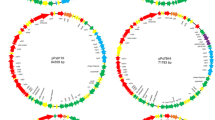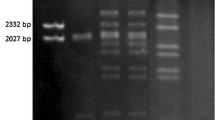Summary
Strain PP808 of Pseudomonas syringae pv. phaseolicola contains pEXC8080 (34.6 kb), the smallest of several plasmids that originated by partial excision of the cryptic plasmid, pMMC7105 (150 kb), from the host chromosome. This excision plasmid is derived entirely of sequences from pMMC7105 and contains a 24 kb region referred to as common DNA, which is present in each of the other excision plasmids. A six enzyme restriction endonuclease map was constructed of pEXC8080. The replication region was mapped by identifying small restriction fragments that conferred replication properties to pMB1 plasmids that otherwise fail to replicate in Pseudomonas. This region is located within the common DNA and is 0.8–3.8 kb in size. Sequences from pEXC8080 failed to stabilize pMB1 derivatives in Pseudomonas in the absence of antibiotic selection, but stability functions were mapped to a region of pMMC7105 that presumably remains integrated in the chromosome of strain PP808. An incompatibility region was mapped to a 7.3 kb region on pEXC8080 that is closely linked to, but not included within, the replication region. The recombination site was mapped to a 1.2 kb region of the fusion fragment that was formed upon excision of pEXC8080. RS-I, a repetitive sequence, found on pMMC7105 was present in the fusion fragment at the site of recombination. RS-I was also mapped to BamHI fragments that recombined upon excision of pEXC8080 and suggest that it provides sites for homologous recombination.
Similar content being viewed by others
References
Bender CL, Cooksey DA (1986) Indigenous plasmids in Pseudomonas syringae pv. tomato: Conjugative transfer and role in copper resistance. J Bacteriol 165:534–541
Bolivar FR, Rodriquez RL, Greene PJ, Betlach MC, Heyneker HL, Boyer HW, Crosa JH, Falkow S (1977) Construction and characterization of new cloning vehicles. II. A multipurpose cloning system. Gene 2:95–113
Comai L, Kosuge T (1980) Involvement of plasmid deoxyribonucleic acid in indoleacetic acid synthesis in Pseudomonas savastanoi. J Bacteriol 143:950–957
Coplin DL (1982) Plasmids in plant pathogenic bacteria. In: Mount MS, Lacy GH (eds) Phytopathogenic Procaryotes, Vol 2 Academic Press, New York, pp 225–280
Curiale MS, Mills D (1977) Detection and characterization of plasmids in Psedomonas glycinea. J Bacteriol 131:224–228
Curiale MS, Mills D (1982) Integration and partial excision of a cryptic plasmid in Pseudomonas syringae pv. syringae. J Bacteriol 153:485–497
Danbara H, Timmis JK (1980) Plasmid Replication Functions: Two distinct segments of plasmid R1, Rep A and Rep D, express incompatibility and are capable of autonomous replication. J Bacteriol 144:1126–1138
Davis RW, Botstein D, Roth JR (1980) Advanced Bacterial Genetics. Cold Spring Harbor Laboratory, Cold Spring Harbor, New York
Ehrenshaft M (1986) Integration and Excision of pMMC7105 in Pseudomonas syringae pv. phaseolicola Occur by Recombination Between Copies of a Repetitive IS-like Sequence. PhD, Thesis, Oregon State University
Ehrenshaft M, Mills D (1985) Construction of a cosmid clone library of Pseudomonas syringae pv. phaseolicola and isolation of genes by functional complementation. Appl Environ Microbiol 50:169–171
Figurski DH, Helinski DR (1979) Replication of an origin-containing derivative of plasmid RK2 dependent on a plasmid function provided in trans. Proc Natl Acad Sci USA 76:1648–1652
Gantotti BV, Patil SS, Mandel M (1979) Apparent involvement of a plasmid in phaseotoxin production by Pseudomonas phaseolicola. Appl Environ Microbiol 37:511–516
Gonzalez CF, Vidaver AK (1979) Analysis of plasmids of syringomycin producing strains of Pseudomonas syringae. In: Proceedings of the 4th Int Conf Plant Path Bact Angers, France, pp 31–38
Gryczan TJ, Hahn J, Contente S, Dubnau P (1982) Replication and incompatibility properties of plasmid pE194 in Bacillus subtilus. J Bacteriol 152:722–735
Jamieson AF, Bieleski RL, Mitchell RE (1981) Plasmids and phaseolotoxin production in Pseudomonas syringae pv. phaseolicola. J Gen Microbiol 122:161–165
Koekman BP, Hooykaas PJJ, Schilperoort RA (1980) Localization of the replication control region on the physical map of the octopine Ti plasmid. Plasmid 4:184–195
Kolter R, Helinski DR (1978) Construction of plasmid R6K derivatives in vitro: Characterization of the R6K replication region. Plasmid 1:511–580
Lane HED (1981) Replication and incompatibility of F and plasmids in the Inc FI group. Plasmid 5:100–126
Leary JV, Trollinger DB (1985) Identification of an indigenous plasmid carrying a gene for trimethylprim resistance in Pseudomonas syringae pv. glycinea. Mol Gen Genet 201:485–486
Maniatis T, Fritsch EF, Sambrook J (1982) Molecular Cloning. Cold Spring Harbor Laboratory, Cold Spring Harbor, New York
Morrison DA (1979) Transformation and preservation of competent bacterial cells by freezing. Methods Enzymol 68:326–331
Niepold F, Anderson D, Mills D (1985) Cloning determinants of pathogenesis from Pseudomonas syringae pathovar syringae. Proc Natl Acad Sci USA 82:406–410
Nordstrom K, Molin S, Aagaard-Hansen H (1980) Partitioning of plasmid R1 in Escherichia coli: kinetics of loss of plasmid derivatives deleted of the par region. Plasmid 4:215–227
Nordstrom K, Søren M, Aagaard-Hansen H (1981) Plasmid R1 incompatibility. Contribution from the cop/rep and from the par systems. In: Levy SB, Clowes, RC, Koenig EL (eds) Molecular Biology, Pathogenicity and Ecology of Bacterial Plasmids. Plenum Press, New York, London, pp 291–301
Ogura T, Hiraga S (1983) Partition mechanism of F plasmid: two plasmid geneencoded products and a cis-acting region are involved in partition. Cell 32:351–360
Piwowarski JM, Shaw PD (1982) Characterization of plasmids from plant pathogenic pseudomonads. Plasmid 7:85–94
Prentki P, Karch F, Shigeru I, Meyer J (1981) The plasmid cloning vector pBR325 contains a 482 base-pair-long inverted duplication. Gene 14:289–299
Quant R, Mills D (1981) DNA homologies among plasmids of Pseudomonas syringae pv. phaseolicola. In: Lozano JC, Gwin P (eds) Proceedings of the 5th International Conference on Plant Pathology and Bacteriology. Calo, Columbia, pp 412–419
Quant RL, Mills D (1984) An integrative plasmid and multiplesized plasmids of Pseudomonas syringae pv. phaseolicola have extensive homology. Mol Gen Genet 193:459–466
Sands PC, Schroth MN, Hildebrand DC (1980) Pseudomonas. In: Schaad NW (ed) Laboratory Guide for Identification of Plant Pathogenic Bacteria. The American Phytopathological Society, Washington DC, pp 36–44
Søren M, Stougaard P, Uhlin BE, Gustafsson P, Nordstrom K (1979) Clustering of genes involved in replication, copy number control, incompatibility, and stable maintenance of the resistance plasmid R1 drd-19. J Bacteriol 138:70–79
Szabo LJ (1983) Genetic recombination of the integrative plasmid, pMC7105, of Pseudomonas syringae pv. phaseolicola involves repetitive sequences. PhD Thesis, Oregon State University
Szabo LJ, Mills D (1984a) Characterization of eight excision plasmids of Pseudomonas syringae pv. phaseolicola. Mol Gen Genet 195:90–95
Szabo LJ, Mills D (1984b) Integration and excision of pMC7105 in Pseudomonas syringae pv. phaseolicola: Involvement of Repetitive Sequences. J Bacteriol 157:821–827
Van Haute E, Joos H, Maes M, Warren G, Van Montagu M, Schell J (1983) Intergeneric transfer and exchange recombination of restriction fragments cloned in pBR322: a novel strategy for the reversed genetics of the Ti plasmid of A. tumefaciens. EMBO J 2:411–418
Veltkamp E, Stuitje A (1981) Replication and structure of the bacteriocinogenic plasmids CloDF13 and ColE1. Plasmid 5:76–99
Author information
Authors and Affiliations
Additional information
Communicated by H. Böhme
Rights and permissions
About this article
Cite this article
Poplawsky, A.R., Mills, D. Identification and mapping of regions that confer plasmid functions and of sites for excisive recombination of plasmid pMMC7105. Mol Gen Genet 206, 265–272 (1987). https://doi.org/10.1007/BF00333583
Received:
Issue Date:
DOI: https://doi.org/10.1007/BF00333583




